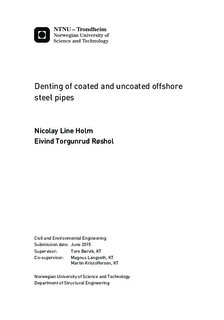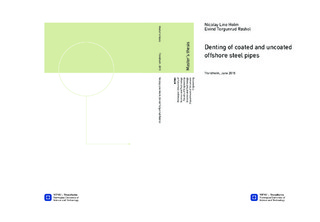| dc.description.abstract | In the present thesis, numerical and experimental investigations of coated offshore pipelines
were conducted. The objective was to investigate how the polypropylene coating affected the global
response of the pipes. The present work was a continuation of previous theses done on X65 steel pipes
without coating, and part of an ongoing research program between SIMLab (NTNU) and Statoil.
The experimental work consisted of material testing and component tests. A tensile test of the X65 steel was conducted, along with a compression test of the PP foam from the coating. The component tests consisted of quasi-static denting of pipes with and without coating, and a compression test of the coating component consisting of all the layers combined.
Numerical simulations of all the tests were carried out with Abaqus/Explicit. A parameter study with a method called Factorial Design was conducted for the coating component. Dent depths of the bare steel pipes were estimated with the recommended practice, DNV-RP-111. Lastly, a new alternative model that takes the PP coating into account was proposed.
The experimental tests showed that for a given level of energy, the coated steel pipes had a significantly
lower inner displacement compared to the pipes without coating. The material model for the PP foam
underestimated the resistance of the coating.
The coating layer in the numerical model initially consisted of one layer based on the PP foam. The Factorial
Design indicated that a numerical model including the inner and outer solid PP layers, would not yield a
significantly higher resistance.
Numerical simulations of the coated steel pipes proved to be difficult. Large deformations in the coating layer lead to contact and distortion problems. The remeshing method ALE improved the simulation significantly, but did not solve the problems with the model entirely.
Estimations done on the bare steel pipes with DNV-RP-111 showed good correlation with the experiments,
for a displacement up to 5-6% of the outer diameter. The proposed alternative model for the steel pipes with coating seemed to be a good start in exploring how polymer coating can be implemented in a recommended practice or standard. | |

